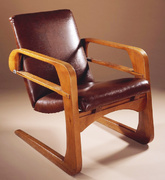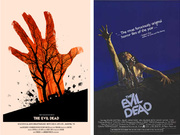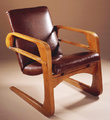
You might not know the brand name Marüshka, but if you lived in the United States in the 1970s or ’80s, chances are its imagery is emblazoned in your brain. You may have blankly stared at a Marüshka silkscreen-on-canvas print while waiting at a doctor’s office, in a hospital, or at a corporate headquarters.
“A lot of the designs are hokey and naive, but they’re fun. That’s why they are so appealing now.”
A Marüshka image of a peaceful sailboat on a lake, a solitary seashell, or a grove of leafless trees may have been in the backdrop of a condo lobby, a hotel room, or a family friend’s bougie-chic living room. Daycares and pediatricians had inoffensive Marüshka clowns, balloons, and puffins on their walls. And at one point, you couldn’t step outside without encountering cute Marüshka sheep or penguins on a sweatshirt.
For those too young to remember the ’80s, the legacy of Marüshka has lived on, through nostalgic collectors and vintage-style wall art offered at stores like Urban Outfitters. Either way, when you see a Marüshka, it’s instantly familiar and evokes a very specific period in time—which is probably why Marüshka prints are popping up in hip Apartment Therapy tours and why obsessive young collectors have emerged, some even forming blogs and Flickr groups to document every Marüshka they unearth from thrift stores and at garage sales.

Naoko Nagano, a 34-year-old shop owner in Chicago, got obsessed with Marüshka prints when she first discovered some while thrifting in the 1990s, and has since collected more than 200 of them. When she and her husband, Malcolm Felder, opened their clothing boutique Study Hall this summer, they joined with Marüshka to reissue a limited run of vintage prints on apparel, housewares, stationery, and even a couple of stretched canvases.
“So many people who’ve come into the store have said, ‘Oh my God! My family had that in their summer home! My family friend had it!’” Nagano says. “It’s funny how something snaps and they remember a specific design.”
Starting in 1974, the Michigan-based company Marüshka produced ready-to-hang wall art in a bold, simple graphic style that evoked Japanese woodblock prints, Pop Art, and Mid-Century Modern textiles by Alexander Girard, who designed for Herman Miller, and the Helsinki firm Marimekko. At Marüshka, linen or cotton canvas would be silkscreened by hand, stretched, and fitted to a wood frame, and then sold for $24 apiece. Company founder Richard Sweet, who passed away in 2007, had a rather sweet notion to democratize art and make it affordable to the public.

“We originated stretched canvas art in that format, where the image fit the frame,” recalls Randy Smith, who had Sweet as a high-school teacher in 1971, started with Marüshka in 1974, and now owns the company. “By the ’60s, Marimekko was doing fabric art, featuring their bold, graphic patterns on fabric stretcher bars. But we were the first to stretch fabric on a wood frame and sell it as an item.”
Despite Sweet’s noble intentions, Marüshka prints are the exact sort of generic, mass-produced decor that high-brow art lovers find hopelessly déclassé. Many of the nature-inspired Marüshka designs telegraph an air of detached sophistication; others, with their bright, generic blocks of color, can seem as chic as children’s jigsaw puzzles and as artful as paint-by-numbers. At the height of their popularity in the early ’80s, Marüshkas were sold throughout the United States through hundreds of distributors. All told, more than one million Marüshka prints were produced.

“It was a cheap way for people to decorate, really,” Smith says. “A lot of them ended up in hotels, public buildings, or hospitals. Dick couldn’t see any reason why art would have to be expensive and why it would have to be framed. A big part of his concept was to avoid the expense of framing. He preferred how it looked anyway, more simple than frilly.”
Sweet himself had a master’s of fine art from Michigan State University and preferred to create simple, earthy brown monochrome designs on tan Polish linen canvas. But he wasn’t above tailoring his work to the taste of his ’80s customers, who also wanted colorful prints for their children’s rooms on cotton canvas. That’s how Sweet and a handful of young designers he hired ended up producing hundreds of unicorn prints, and hundreds more cat images. Other experiments, like an attempt to exploit the fitness craze with scenes of faceless white people playing sports, flopped.

“People want you to do stuff, so you try it, and then you find out there’s no demand for it,” Smith says. “We sold maybe 48 of the sports prints, like the lady in leg warmers and the people playing tennis. It didn’t really fly. What were we thinking? They are so corny, but I think that’s why they are so appealing to people now. A lot of the designs are hokey and naive, but they’re fun. That’s why people collect them.”
Those strange, garishly colored sports prints are the first Marüshkas Nagano ever purchased at a junk store when she was living in Michigan. She instantly fell for the simple lines and retro color palette, and the pieces were cheap, too. She says the fact that Marüshka made so few of such designs is part of the fun.

“Marüshka has so many designs, it’s a challenge to find all these different ones,” she says. “Obviously, you see the most popular designs over and over again. But then, you start talking to other people who collect them, and it’s like, ‘Oh do you have this one? Do you have that one?’ It becomes a thrill to hunt for the most obscure Marüshka. Definitely, a few friends and I were competing to find them.”
Sweet certainly didn’t start out trying to be so hip. He was working as a public-school art teacher in Grand Haven, Michigan, when he quit his job in 1971 to start a silk-screen textile design company, which he named after his school librarian wife, Mary, using “Marüshka” or the Polish version of her name. After working for a year in Grand Rapids with partners Victor and Mary Krawczyk, he moved struck out in his own in 1972, moving to Spring Lake, where he made graphics for cubicle partitions and contract furniture in a building a behind an old car wash.

As corporate and boring as they may sound now, office partitions and wall panels gave Sweet huge canvases, 4 feet by 6 feet or larger, to create graphic art—albeit within a predetermined color scheme. He got gigs with Mid-Century Modern innovators like Herman Miller and Steelcase, who showcased his work at the big Chicago trade show called NeoCon. And he landed plum projects, like designing panels for the new Citicorp building’s cafeteria in New York City.
But Sweet didn’t begin making the smaller prints, like the ones you find in thrift stores and at garage sales today, until 1974. Inspired by the sights from the Lake Michigan shoreline, these were much closer to his heart than the partitions: big orange moons over the water, ducks floating among foxtails, shore birds swooping past falling stick fences, and serene lighthouses and sailboats.

“In 1974, he started doing those as a hobby and selling them on the Lake Michigan waterfront,” Smith says. “That summer, I began working with him, offering those to gift shops and retailers around Michigan. In the fall, I sold them out of my car on the way to Florida, wholesaling them to small retailers. I lived in my car for 30 days, literally, and shaved with a rechargeable razor in the rearview mirror.”
Soon, Sweet and Smith were selling Marüshka prints featuring nautical or beach-themed images like seashells in Florida as well. After their first trade show in Dallas, Texas, in 1975, the duo connected with representatives to sell at gift shops all over the country. These hand-printed artworks turned out to be a far better business than the office furniture; between 1974 and 1990, Marüshka produced at least a million prints.

The earliest monochrome Marüskha prints, called Field Prints, embraced the back-to-nature movement of the 1970s. There were groves of stark, leafless trees, close-ups of wildflowers and butterflies, and seashells like conches, sand dollars, nautiluses, and clams, all printed in a distinctly ’70s palette of autumnal oranges, muddy browns, mustard yellows, and olive greens that played on the natural and obvious grain of the Polish linen canvas.
“Dick liked clean, simple art; he didn’t like convoluted or contrived things,” Smith says. “The original pieces were very clean and graphic. Eventually, the designs became more about what the customer wanted. He would have never done unicorns if there wasn’t a market for it. We learned to give ’em what they want, like the clowns. His real style was more like a two-color graphic design. He liked the earthy stuff, the brown on natural linen.”

As an artist, Sweet preferred contemporary art to old masters, with a particular love of Pop Artists like Andy Warhol, Roy Lichtenstein, and Keith Haring, who started out as a New York subway artist and eventually moved to screenprinting.
“So many people have said, ‘Oh my God! My family had that print in their summer home!'”
“Dick was always more contemporary than quaint,” Smith explains. “He and his wife had teak Danish Modern furniture. He collected Herman Miller chairs. In his last 20 years, though, he started collecting outsider art. That was a big shift for him.”
In 1980, the Solidarity movement in Poland prevented Marüshka from importing linen for a full year. That’s when the company focused on the multicolored prints of things like hot-air balloons on cotton, before reintroducing Sweet’s more natural linen designs to the line a year later. You know Sweet had a sense of humor about himself when he listed a print as “More Dead Trees” in a catalog. (See tree prints below.)

By 1982, Marüshka was so wildly popular that competitors were springing up all over the place, including International Printworks. Grand Haven alone had four other companies churning out silkscreen art.
“It gave people an opportunity to put things in their cottage that related to the water in front of it without spending a fortune,” Smith says. “People could relate to it. There were some goofy things, like the unicorns, but some of the designs are ageless. Sometimes the ones that are obscure, like the frogs, or the weird ones that we did back then are the ones that people like. At the time, we’d sell all kinds of cat designs—holy crap, so many cat designs!”

Many of the shoreline and forest images were offered as triptych, producing the effect of looking at the same scene through different windows.
“We’d sell all kinds of cat designs—holy crap, so many cat designs!”
“We did that because people were buying sets of the prints to group them,” Smith says. “For example, down in Florida, people would buy three different shells to hang together. So we made it simple for them to buy the matching triptych to hang behind their couch, and they wouldn’t have to think about it. It was a way to sell three prints instead of one.”
In 1985, Sweet and Smith co-founded the Michigan Rag Company to sell apparel. Bright rows of tulips, dancing lines of fat penguins, adorable puffins, and eyeless sheep (one black, of course) make their way from wall hangings to T-shirt and sweatshirt graphics.

That same year, tastes in affordable wall art started to change, Smith says. Big art museums began issuing full-color photographic posters of their most beloved artworks with the institution’s name on in a color bar along the bottom. People would frame these reproductions of Monets and O’Keefes and hang them behind their couches instead of stretched silkscreened canvases. By 1990, Marüshka prints were completely out of fashion.
“People were buying a lot of posters then, and that hurt us,” Smith says. “At the same time, we did some paper serigraph posters, and in a way, they’re some of the most arty things we’ve ever done. But back then, nobody understood them; they wanted the glossy posters that had the museum down below. But now, if you look at it, you’d say, ‘Holy cow, I’d take this any day over cranked-out photo posters!’ We all got out of the business back then, International Printworks, everyone. But in the last 10 years, it’s changed back.”

In the 1990s and 2000s, Sweet and Smith stayed afloat with their apparel business, Michigan Rag Company, and in just the last five years, Smith has started issuing clothes under the Marüshka brand name. Fortunately for him, young hipsters pilfering thrift stores in the 2000s rediscovered Marüshka, which fits right in with their shabby-chic Modern decor. Unfortunately, not all vintage Marüshka prints are in great shape.
“The problem is when they ended up in public buildings, they got pretty shop-worn,” Smith says. “I’ve seen ’em where the edges are frayed, or the color has worn off. A lot of those got beat up pretty quick. In hotels, the owners would screw them to the wall. People would try to wash them, and you can’t really wash them, because they end up with a water spot. Most of the good ones are from places where people have had them in a cottage and they never moved.”

And then last year, Naoko Nagano and Malcolm Felder approached Smith about collaborating on a line of Marüshka products, using the vintage images. They were delighted to discover that Smith has all of the original art, carved into Rubylith film with an X-Acto knife by Sweet and a handful of other company designers. “It’s all here in blueprint files,” he says.
“Randy was pretty psyched on our idea, so went to the Michigan Rag Company store in Grand Haven, and pulled some of our favorite designs from the old catalogs,” Nagano says. “The studio is amazing. They had all these experiments they had done. Because they had their own studio, they played around.”

When Nagano and Felder opened Study Hall last summer, they introduced the new clothing, stationery, tote bags, and housewares using vintage Marüshka imagery of toucans, raccoons, strawberries, begonias, poppies, sailboats, trees, and beaches. They’re also selling hand-printed posters and gift wrap that Smith had on hand.
“There’s been a really good response to our Marüshka collection, I think, because there’s something familiar about it,” Nagano says. “People might not know Marüshka, but once they see it, they recognize it. There are also tons of Marüshka fans who have found us online, or those who live in Chicago and have read about the collaboration come in. We’re looking to do a new collection with them this spring.”
Smith is capitalizing on the renewed excitement for his company, too.

“I go back into the old archives about once a week to find things we can sell, or to see if we can reconfigure it,” Smith says. “There’s a sand dollar that we do now as a T-shirt that was done in 1972 as a wall print. We have a client in Connecticut who asked for a daffodil design this morning. I went down to the blueprint files and pulled out the daffodil design, probably from 1987. And if you look at the Rubylith form, it’s a work of art in its own right.”
While Marüshka prints will never be considered high art, the hand-crafted and graphic nature of the designs definitely appeal to young people who are craving both authenticity and retro Modernist aesthetics.
“Everything handmade is coming back, whether it’s artisanal foods or silkscreen prints,” Nagano says. “Instead of going for a reproduction of a Monet, people are more inclined to see a Marüskha and say, ‘This is special. This was made by hand.’ For their home, people want something that has some character.”

The images of vintage wall prints come from the Marüshka Prints blog, the Marüshka Flickr Pool, or the Marüshka Preservation Society.

 Kem Weber: The Mid-Century Modern Designer Who Paved the Way for IKEA
Kem Weber: The Mid-Century Modern Designer Who Paved the Way for IKEA
 Does Facebook Have a Secret Paper Fetish?
Does Facebook Have a Secret Paper Fetish? Kem Weber: The Mid-Century Modern Designer Who Paved the Way for IKEA
Kem Weber: The Mid-Century Modern Designer Who Paved the Way for IKEA Mondo: The Monster of Modern Movie Posters
Mondo: The Monster of Modern Movie Posters FabricAntique and vintage fabric runs the gamut from Middle Eastern silk to 1950s…
FabricAntique and vintage fabric runs the gamut from Middle Eastern silk to 1950s… PrintsPrintmaking is a very old art form, dating, in the case of woodblock prints…
PrintsPrintmaking is a very old art form, dating, in the case of woodblock prints… Mid-Century ArtThe Mid-Century Modern aesthetic didn’t just infiltrate architecture and fu…
Mid-Century ArtThe Mid-Century Modern aesthetic didn’t just infiltrate architecture and fu… Mari Tepper: Laying it on the Line
Mari Tepper: Laying it on the Line Nice Ice: Valerie Hammond on the Genteel Charm of Vintage Canadian Costume Jewelry
Nice Ice: Valerie Hammond on the Genteel Charm of Vintage Canadian Costume Jewelry How Jim Heimann Got Crazy for California Architecture
How Jim Heimann Got Crazy for California Architecture Modernist Man: Jock Peters May Be the Most Influential Architect You've Never Heard Of
Modernist Man: Jock Peters May Be the Most Influential Architect You've Never Heard Of Meet Cute: Were Kokeshi Dolls the Models for Hello Kitty, Pokemon, and Be@rbrick?
Meet Cute: Were Kokeshi Dolls the Models for Hello Kitty, Pokemon, and Be@rbrick? When the King of Comedy Posters Set His Surreal Sights on the World of Rock 'n' Roll
When the King of Comedy Posters Set His Surreal Sights on the World of Rock 'n' Roll How One Artist Makes New Art From Old Coloring Books and Found Photos
How One Artist Makes New Art From Old Coloring Books and Found Photos Say Cheese! How Bad Photography Has Changed Our Definition of Good Pictures
Say Cheese! How Bad Photography Has Changed Our Definition of Good Pictures Middle Earthenware: One Family's Quest to Reclaim Its Place in British Pottery History
Middle Earthenware: One Family's Quest to Reclaim Its Place in British Pottery History Fancy Fowl: How an Evil Sea Captain and a Beloved Queen Made the World Crave KFC
Fancy Fowl: How an Evil Sea Captain and a Beloved Queen Made the World Crave KFC
Being from Michigan, I have always loved and collected Maruskas.
I think the sports art has an appeal today that the other paintings lack. The one published here looks a lot like vintage video game art.
Thanks for shooting this through to me guys, I had no idea about Marüshkas – so a big education for me. Appreciate you sharing :)
I babysat for Dick and Mary Sweet back in the late 1970s (when she was a high school librarian). They were a great couple, gave me some prints when I graduated and I still think of them fondly every time I run across the prints.
Not only is this an overdue (and brilliant) article, it was one I intended to write, but “Speedy Hix” has outdone me again. Dick and Mary Sweet were huge influences on me…Mary as a librarian in particular. My mother was a Librarian there at the same time. They were recognized by their students, at the school I attended, as the bright, friendly, non-judgemental, creative and most loving educators one could EVER hope to find, and they were both beacons of Freedom of Expression and creativity at a time (the late 1960s and early 1970s) when that was a bit under attack in a conservative small town. They were, and are heroes to me still today. To the extent It is an honor to be able to contribute this comment. Thank YOU! Jim Linderman Dull Tool Dim Bulb the Blog
just attended an estate sale where I was able to purchase about 40 vintage Un-framed Marushka’s from the early years! Some from I believe the pre-Marushka era, signed R. Sweet! I love them and will keep a few but the others are being listed on EBay for others to enjoy! It was a thrilling find!
What a fun article! In 1980’s , as an MSU grad student, I took a weekend roadtrip w a friend.one of our stops was a Marushka shop. We bought unframed unstretched prints and glasses w beach grass and birds. Big budget stretch! A few still hang in a NC beach home, and some of the glassware is still in use. Just found several unstretched canvases in the bottom of a bin of fabric, including one of a trillium on a blue background, and some shells, also on blue background. Great pieces, great memories!
How cool! I found 2 Marushka’s in a thrift store in the early 90’s when I got married and bought my first house. My wife and I loved them and always had them proudly displayed. Knowing nothing about them, we always said, ” Who knows, they may be worth a fortune some day.” Well, we got divorced a few years later. I took them, a truck, the TV, my tools, my guitar and the waffle iron. I still proudly display the Marushka’s. I think they’re beautiful and timeless! Great article, thanks.
Dick was my uncle and i worked at one of his stores..selling and strecthing prints (got sick of strecthing real quick) lol..he was always fun to be around and i laugh when i see his prints at garage sales and thrift stores..never thought there would be a revival
Have a few maruska prints,The Meistro, for example,would like the know what they are worth…ty
I have a Marushka that I no longer have a need for. Where is a good place to take to get something for it. I am in North West Indiana. Thank you.
JUST ran across this article. From central Illinois, i moved to Madeira Bch, Fla in 1981. I quicky procured a job as mgr of a Fabric Art Shop on Johns Pass Boardwalk — just opened. We sold full line of Marushka and International Printworks. It was like Marushkas were made for US!! Ive never enjoyed any other job as much! I never got tired of the stretching and framing — I did thousands!! I did a LOT of trapunto on the canvas, often custom orders, giving the designs a 3-D effect. The owners of the store soon opened another shop inland a couple miles, and my time was divided. Meanwhile Sharon McCord bought a Maruska company store in Dunedin and ‘borrowed’ me from the other stores, dividing my time between 3 shops. There was never any feeling of competition, there was enough demand for even MORE stores to to open! And they did! At the Dunedin store, we added outside sales, so i was scrambling between hospitals, corporate buildings, medical and lawoffices, hotels, and restaurants to bring them affordable, pleasing art that fit anywhere. These corporate settings inspired a whole mob of new customers to our 3 shops. I finally became overwhelmed and went into interior decor around 1987. I have boxes and boxes of the canvases in storage, and this article inspires me to bring them out to share. I still spot several i sold to hospitals , when visiting, proving their endurance and appeal. I look back on those years as the most endearing, and am forever grateful Marushka and I had the opportunity to bring so much enjoyment to so many people. I LOVE the newer designs and am so happy the Marushka tradition is carried on! Happy memories of a delightful art form!
I’m trying to identify my marushka painting